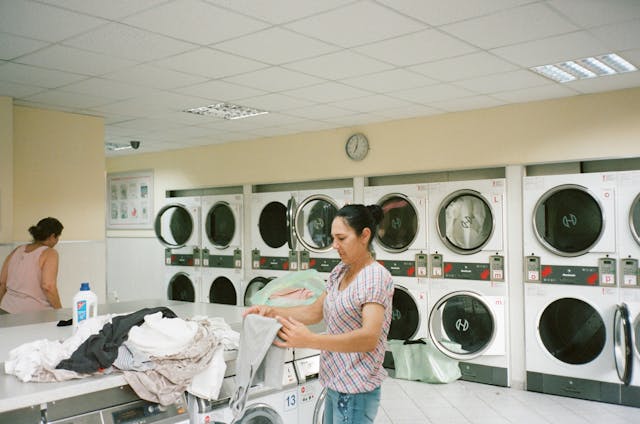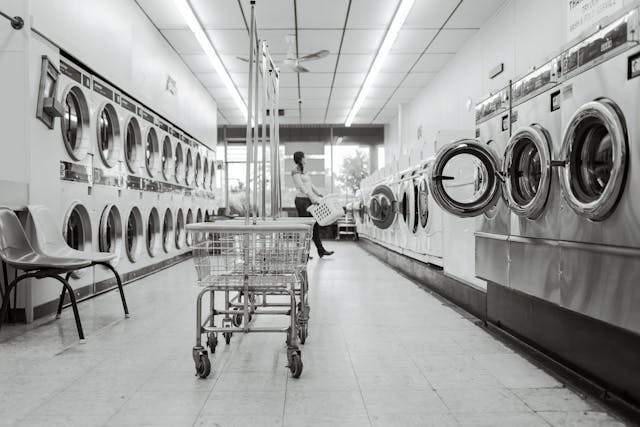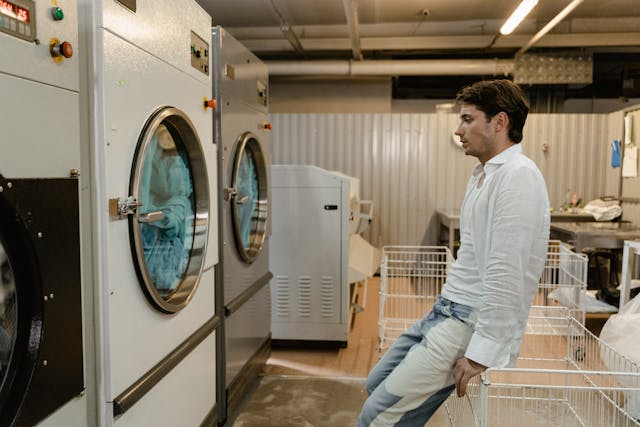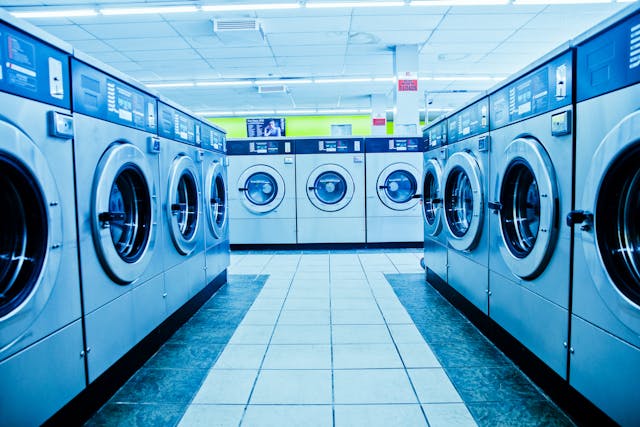How Much Do Laundromats Make? A Comprehensive Look at Laundromat Earnings
Laundromats have become a common sight in many neighborhoods, providing a convenient place for people to wash and dry their clothes. However, have you ever wondered how much money these businesses make? The answer may surprise you.
According to industry reports, the average laundromat can generate between $15,000 to $200,000 in annual revenue. The amount varies depending on factors such as location, size, and the number of machines available. In general, laundromats located in densely populated areas tend to make more money than those in rural areas. Additionally, larger laundromats with a greater number of machines can accommodate more customers at once, resulting in higher revenue.

Understanding the Laundromat Business Model
Laundromats are a popular business venture that can generate significant revenue if managed properly. Understanding the business model is essential for anyone considering investing in a laundromat.
Revenue Streams
Laundromats generate revenue through a variety of streams. The primary source of income is from the use of washing machines and dryers. Customers pay a fee to use the machines, which can vary depending on the location and type of machine.
Another source of revenue is vending machines. Many laundromats offer vending machines that sell items such as detergent, fabric softener, and snacks. These machines provide an additional stream of income for the business.
Wash-and-fold services are also a revenue stream for many laundromats. Customers drop off their laundry and the business washes, dries, and folds the clothes for a fee. This service can be a significant source of income for a laundromat.
Cost Structures
Running a laundromat involves several expenses that must be taken into consideration. The cost of utilities, such as water, gas, and electricity, can be significant. Maintenance and repair costs for the machines and the building must also be factored in.
Employee wages and benefits are another significant expense for laundromats that offer wash-and-fold services. The cost of supplies, such as detergent and fabric softener, must also be considered.
Despite the expenses, laundromats can be profitable if managed effectively. By keeping expenses low and maximizing revenue streams, a laundromat can generate a significant profit for the owner.
Key Factors Affecting Laundromat Profits
Laundromats can be a profitable business if managed correctly. There are several factors that can affect the profits of a laundromat, including location, equipment, and operational efficiency.
Location and Competition
The location of a laundromat is a critical factor in determining its profitability. A laundromat located in a densely populated area with a high demand for laundry services is likely to be more profitable than one located in a less populated area. Additionally, competition from other laundromats in the area can also affect profitability. If there are several laundromats in the same area, it may be difficult to attract customers.
Equipment and Maintenance
The quality and condition of the equipment in a laundromat can also affect profitability. Customers are more likely to use a laundromat that has modern and well-maintained machines and dryers. However, purchasing and maintaining equipment can be costly, which can affect profitability. It is essential to balance the cost of equipment and maintenance with the revenue generated by the laundromat.
Operational Efficiency
Operational efficiency is another critical factor in determining the profitability of a laundromat. Efficient operations can help reduce costs and increase revenue. For example, marketing campaigns can attract new customers, while effective operations can help retain existing customers. Additionally, reducing utility costs and maintenance costs can help increase profitability.
In conclusion, several factors can affect the profitability of a laundromat, including location, competition, equipment, and operational efficiency. By carefully managing these factors, laundromat owners can create a profitable business that meets the needs of their customers while minimizing costs and maximizing revenue.

Financial Planning and Investment
Starting a laundromat business requires careful planning and forecasting to ensure profitability. A well-thought-out business plan is essential to determine the initial investment, start-up costs, and financing options.
Startup and Operational Costs
The initial investment for a laundromat can vary depending on the location, size, and equipment. The cost of leasing or purchasing a space, buying washers and dryers, and other necessary equipment can add up quickly. Additionally, there are fixed costs such as utilities, insurance, and maintenance, as well as variable costs such as water and electricity usage.
To determine the profitability of a laundromat, it is important to calculate the gross margin, EBITDA, and cash flow. Gross margin is the difference between revenues and variable costs, while EBITDA is the earnings before interest, taxes, depreciation, and amortization. Cash flow is the amount of money that flows in and out of the business.
Financing and Return on Investment
Financing options for a laundromat include traditional loans, Small Business Administration (SBA) loans, and private investors. Due diligence is necessary to ensure that the financing terms are favorable and that the return on investment (ROI) is sufficient.
The ROI for a laundromat can vary depending on factors such as location, competition, and marketing efforts. However, owning a laundromat can provide passive income and long-term profitability with careful planning and forecasting.
Overall, the laundromat industry can be a profitable venture for small businesses with a clear understanding of startup and operational costs, financing options, and ROI. With careful planning and forecasting, owning a laundromat can provide a steady stream of income and a valuable asset for future valuation.
Maximizing Laundromat Revenue
Laundromats have the potential to generate significant revenue if managed properly. Here are some ways to maximize revenue:
Additional Services and Products
Offering additional services and products can increase revenue and attract more customers. Vending machines that sell snacks and drinks can provide an additional source of income. Adding an ATM machine can also be beneficial as it provides convenience to customers and generates transaction fees for the laundromat. Additionally, offering pickup and delivery services can attract busy customers who are willing to pay extra for convenience.
Marketing Strategies and Customer Retention
Marketing is essential for attracting new customers and retaining existing ones. Offering discounts or loyalty programs can encourage repeat business. Social media platforms can also be used to promote the laundromat and engage with customers. Providing entertainment such as televisions or magazines can enhance the customer experience and keep them coming back.
It is important to note that the average revenue of a laundromat varies depending on location, size, and competition. The income generated from washers and dryers is the primary source of revenue for laundromats. Profit margins can be increased by ensuring machines are properly maintained and energy-efficient.
In conclusion, maximizing revenue for a laundromat requires offering additional services and products, implementing effective marketing strategies, and maintaining machines for optimal performance. With these strategies in place, laundromats can generate significant income and maintain a loyal customer base.

Analyzing the Market and Future Trends
Market Analysis and Demographics
The laundromat industry has been growing steadily in recent years due to the increasing demand for laundry services. The market size is expected to grow even further in the coming years, especially in populated areas where people have limited access to laundry facilities.
One of the key factors that affect the profitability of a laundromat is the competition in the area. It is important to conduct a thorough market analysis to identify the existing competition and their strengths and weaknesses. This will help the laundromat owner to develop a competitive advantage and attract more customers.
Another important factor to consider is the demographics of the area. The laundromat owner should analyze the population density, age distribution, and income levels of the area to determine the target market. This will help in setting the right prices and developing marketing strategies that will appeal to the target market.
Emerging Trends and Technologies
The laundromat industry is constantly evolving, and new technologies are emerging that can help laundromat owners to improve their operations and increase profitability. One of the emerging trends is the use of mobile apps to book and pay for laundry services. This technology makes it easier for customers to access laundry services and can help to increase turnover.
Another emerging technology is the use of smart machines that can monitor and control the utilization rate of the machines. This technology can help to reduce the operating costs of the laundromat and increase profitability.
In conclusion, analyzing the market and keeping up with emerging trends and technologies is crucial for the success of a laundromat business. By understanding the market size, competition, demographics, and emerging trends, the laundromat owner can make informed decisions that will help to increase profitability and achieve the break-even point.
Frequently Asked Questions
What is the average monthly income for a laundromat?
The average monthly income for a laundromat can vary greatly depending on the location and size of the business. However, according to industry estimates, a typical laundromat can generate anywhere from $5,000 to $20,000 in monthly revenue.
What are the typical daily earnings for a laundromat business?
Again, daily earnings for a laundromat business can vary depending on factors such as location and size. However, on average, a laundromat can earn anywhere from $200 to $1,000 per day.
What annual profit can a laundromat owner expect?
The annual profit for a laundromat owner can also vary depending on the factors mentioned above. However, according to industry estimates, a typical laundromat can generate anywhere from $20,000 to $80,000 in annual profit.
Is owning a laundromat a viable side business?
Yes, owning a laundromat can be a viable side business for those who are willing to put in the time and effort to manage the business effectively. However, it is important to note that running a successful laundromat requires a significant investment of time and money.
What are common challenges faced by laundromat businesses?
Common challenges faced by laundromat businesses include competition from other laundromats, equipment maintenance and repair costs, and managing customer complaints and disputes. Additionally, laundromat owners must stay up-to-date with industry trends and regulations in order to remain competitive.
How can one start a laundromat business with minimal initial investment?
Starting a laundromat business with minimal initial investment can be challenging, but it is possible. One option is to look for existing laundromats that are for sale and negotiate a favorable purchase price. Another option is to consider a franchise opportunity, which may offer financing and other support to help get the business up and running. Additionally, some laundromat owners have had success with crowdfunding campaigns to raise the necessary funds.




